Part 11: Intermission the First
 : Intermission, hee-ho!
: Intermission, hee-ho! : Wait. What.
: Wait. What.*: You heard the man.
 : But... But!
: But... But!*: You went directly to jail, didn't pass go, and didn't collect 200 Macca. It's intermission time now. Deal with it.
 : This delay is the worst thing that's happened to me since my hometown was wadded into a ball and nearly everyone I've ever known, loved or hated was disintegrated. So, uh, well. Not so bad, in the grand scheme of things.
: This delay is the worst thing that's happened to me since my hometown was wadded into a ball and nearly everyone I've ever known, loved or hated was disintegrated. So, uh, well. Not so bad, in the grand scheme of things.*: Anyway, I'm taking over for today, and I'm dropping the italics momentarily because that'll get obnoxious right quick.
1. Music
The bulk of the tracks in Nocturne were composed by Shoji Meguro, with a few by Kenichi Tsukiya and Toshiko Tasaki. Meguro's been composing for Atlus since 1996's Revelations: Persona, and is still working on the greater series' music today, with his name in the credits of Persona and Devil Summoner games, as well as Trauma Center and Catherine. Nocturne was his fifth soundtrack, following Maken X on the Dreamcast and its PS2 remake. Additionally, a number of themes and melodies are reprised from Tsukasa Masuko's equally spectacular work earlier in the series.
This is easily one of my favorite soundtracks of all time, all mediums. I... Hmm. Everything I was gonna type in this paragraph boils down to "I'M A HUGE GOD-DAMNED FANBOY", so I'll just start putting up links to the tracks we've heard so far and let the music speak for itself if I can't think of anything specific to say. Oh, and there will be stuff I haven't linked to yet, including most battle themes which I've been pretty terrible at mentioning.
Apocalypse
This is the song that plays during the very first cutscene, the train dream featuring Ms. Takao. (By the way, according to youtube, it appears half of you missed that cutscene entirely, which is probably because I hadn't started flagging them with
 yet. So if you don't recall a dream with Ms. Takao or a name entry screen for our protagonist, go take a look!) The delicate, hopeful melody really helps set up Yuko as a kind, well-intentioned character, giving us a bit of a mood whiplash when we later realize she's conspiring with cultists to destroy the world.
yet. So if you don't recall a dream with Ms. Takao or a name entry screen for our protagonist, go take a look!) The delicate, hopeful melody really helps set up Yuko as a kind, well-intentioned character, giving us a bit of a mood whiplash when we later realize she's conspiring with cultists to destroy the world.Large Map ~ Real Universe
Well, the Vortex World is real too, in the context of the game. But here "real universe" refers to the segment of the game world that is similar to the world we live in. All in all, it's not a track we get to hear for very long!
Shinjuku Hygienic Hospital
Tense, but still delicate and low-key somehow, a perfect fit for the eerily deserted hospital.
Hikawa
Hikawa himself doesn't look threatening at first glance, but this slow-paced piece immediately gives you the impression that this is a man both powerful and dangerous.
Tokyo Conception
Beautiful in piano, then majestic in organ, then impossibly effing badass on guitar. This piece is a triumph. In-game the first portion can loop on its own, since you control the pace of the "conversation" with Ms. Takao.
Normal battle
This is the most common battle theme, used for fights in dungeon-type areas (like the Shinjuku Hospital or the Great Underpass) that don't have another track associated with them. Amazingly, the vocal parts are actually in English. Or... in Engrish, at any rate. There are no definitive lyrics anywhere I can find, but the version I prefer for this one is...
quote:
Your faith is a haunting curse
Please, I'm just a human being
Whatever doesn't impress it unto me
Please make this a pure world
Mystery
This is the track that plays when we're conversing with Dr.Dark in our first involuntary venture in the Labyrinth of Amala. It pops up again here and there, but it's not associated with anyone in particular.
Fierce Battle
This is one for non-boss fixed encounters; for example, the Nekomata fight in the club, the Troll fight behind Nyx's Lounge, or the Succubus guarding the Cube in the backyard of the Nihilo base. A few lines of the lyrics still seem open to interpretation, but it seems more sensical than the other voiced tracks. In fact, the last verse is quoting the biblical book of Revelations!
quote:
I am the bug inside you
I have you forever to hold
Survive the fall from grace
Drink of the wine of the wrath of God
One more god rejected!
I am the bug inside you
One more god rejected!
I have you forever to hold
One more god rejected!
Survive the fall from grace
One more god rejected!
Oppose the wrath of God!
Fear!
Fear God and give glory to Him
For the hour of his judgement has come to you
Now!
When the thousand years have expired
Satan will be released
Judgement has come to you
Large Map
Suprisingly laid back, given the game's tone. I still can't help but hum along to the piano every time I hear it, even after all these years.
Shibuya
Recovery Spring
Heretic Mansion
Chiaki
Hey.
Normal Battle ~ Town
This one's for battles in town-type areas, like Shibuya and Ginza. It starts out so dang jazzy! Lyrics seem a bit iffier on this one.
quote:
Power in the Reasons that we are all fighting for
You've given up your body and soul and heart
Yes, some of us hasten on like lambs to the slaughter
Get the power to reach the next stage
Ginza
For a long time I didn't realize Nocturne wasn't composed by the same guy who did SMT1 and 2, and this is probably a reason why.
Normal Battle ~ Amala Network
This one is for battles in the Amala Network, natch. It has practically the same bassline as the SMT1 battle theme so for a while I thought it was a bit of a remake of it, but it's also real similar to the Shin Megami Tensei If battle theme.
Jewelry RAG
Ikebukuro
Playing the Fool
Uuuuurgh... So... jaunty!
Boss Battle
More debatable, cryptic lyrics!
quote:
We'll sacrifice the son of heaven
Man's greatest glimpse of fire red
Oh how they're lost in their prayers for our greatest god
Let me sleep, please!
I am a man, half human
I am tired, as heart and person weaken
On the name of God!
I will not crack
Can you hear them?
God!
I will not crack
Can you hear them?
Normal Battle ~ Large Map
And another battle theme, this time for all overworld fights. This one's probably my favorite of the lot, but by the tiniest margin.
quote:
Maybe you have ought to suffer
You have doomed creation and fate
You lead them all to death
You little demon are caught in our web
Junk Shop
Heretic Mansion ~ Shining Heaven
One of the many Cathedral themes, for full Kagutsuchi.
Manekata
We've heard it only briefly during our arrival in the Manikin hideout.
Boss Appearance
This version of the final section of the Tokyo Conception track plays before pretty much every major boss battle, usually during their pre-fight trash talk session. It is Perfect.
Game Over
To me, every SMT game over screen is equal parts beautiful and terrifying. Shit no I don't want to go there yet, just send me back to all the demons and stuff, I got work to do!
Amala Labyrinth
Battle ~ Amala Labyrinth
And of course, there's a battle theme for the Amala Labyrinth because this game has to have so many battle themes. All the battle themes.
SHOWTIME!!! ~ Dante's Theme
And this is the first of Dante's two themes,
Lord of the Netherworld
Lucifer's theme song, of course. I can't possibly say enough good things about this piece. Melancholic and majestic, sinister and hopeful. Nocturne's OST is one of my favorite soundtracks of all time, and Lord of the Underworld is one of my favorite individual tracks ever. Okay I'm fanboying again; next, quickly.
Oh wait, that's it for now. Whew!
2. Elements and Mitama
Elements and Mitama are two special races that have unique effects when fused with other demons.
Elements are obtained by fusing two demons of the same race together, or by trading them for gems. They're typically not much use in combat, but in the Cathedral of Shadows, they "rank up" or "rank down" whatever demon they are fused with. A rank up fusion turns the demon in the next most powerful demon of the same race; for example, it would turn Fairy Pixie into Fairy High Pixie, or Haunt Preta into Haunt Choronzon. Ranking up the highest level demon of a given race wraps around, resulting in the weakest demon of that race. And I'm sure you can figure out what rank down fusion does. Different races rank up or down with different Elements.
If the protagonist is suffering from a Curse ailment inflicted by his magatama, an Element that would normally rank up a given race will rank it down instead, and vice versa.
Mitama are obtained by fusing two Elements together, or by trading them for combinations of gems, one of which is always a Jade. When fused with a demon, the demon essentially remains the same, except that one of its stats is permanently increased (which stat depends on the specific Mitama), and the Mitama grants a number of its skills as per standard fusion rules. Being able to increase a demon's stats through Mitama fusion is among the reasons you don't want to spend Incense on your allies.
3. Geography
I may never have been to Tokyo, but I've still always found the fact that the overworld map in SMT1 matches up fairly well with real world geography is all kinds of amazing. I can only imagine how that sort of thing would make me feel if I actually lived there and walked these streets every day. One of my favorite little moments in previous LPs is being told to go to a specific place without being given any directions, then pulling up Google Maps, figuring out an itinerary online, and applying that itinerary in the game. Can't do that in Dragon Quest, lemme tell ya.
Of course, the Tokyo Conception messed up the landscape something fierce, but I still thought it'd be neat to see how the path we've taken matches up to the real Tokyo, and perhaps give us an idea of the exact size of the Vortex World.
Our trip starts in Yoyogi Park Station, which is almost definitely Yoyogikoen Station, plopped right in the southwestern side of Yoyogi Park proper.
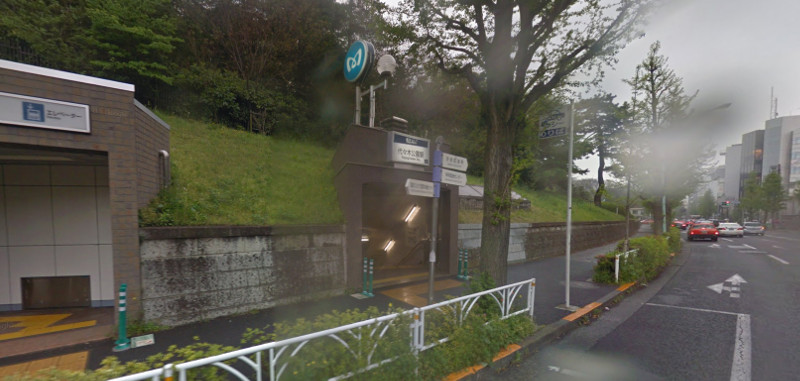
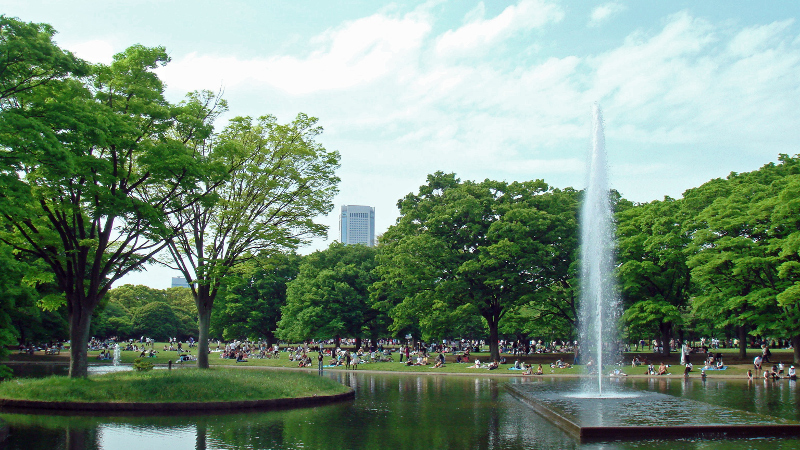
From there, we go northeast, around the locked-up park, to an area roughly east of Shinjuku Station. There are multiple medical facilities in Shinjuku, none of them matching the twin u-shapes we know and love, but it's not like I expected that den of eschatological cultists to be based on a real place. So we can only estimate a general area for this step.

And from then, of course, the world crumpled up like a failed exam paper. We made our way west, then south with a pit stop in Yoyogi Park, and back east towards Shibuya and its iconic Hachiko intersection.
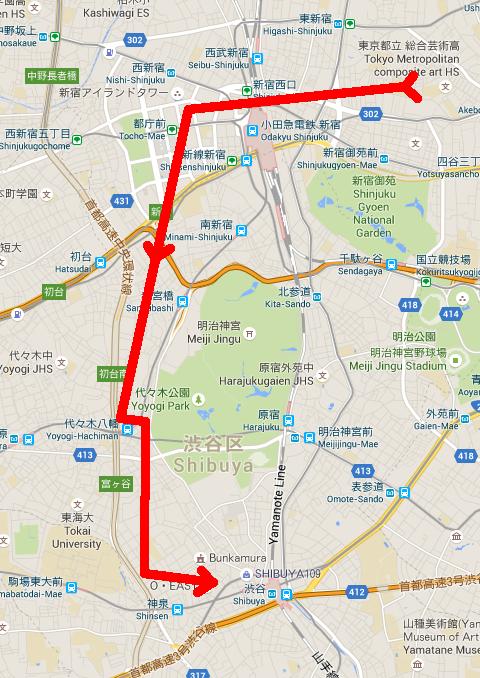
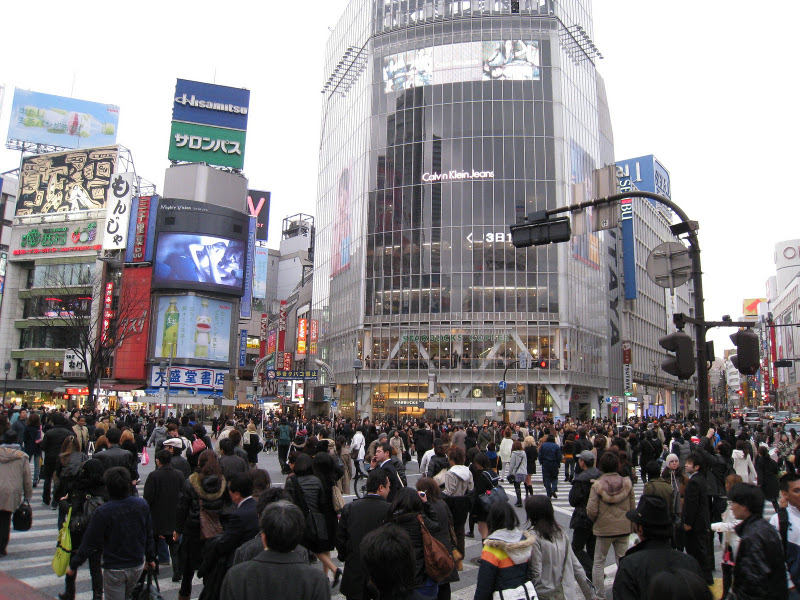
Our next step took us through the plumbing of the universe, vanishing from Shibuya, then reappearing in Ginza. We did take a small detour through Hell, but I can't seem to find that one on Google Maps for some reason, unless we're talking about Hell, Michigan.
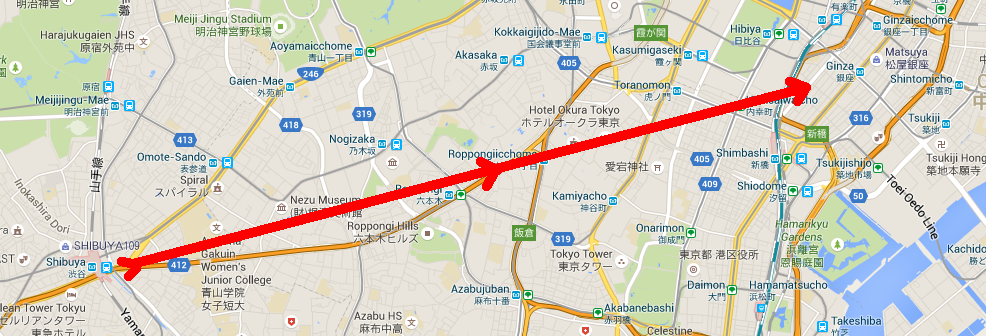
We briefly visited Shiodome, the site of the Assembly of Nihilo...
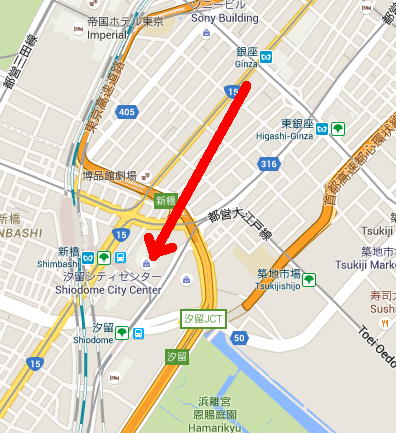
...then we were redirected east. At first we followed the highway, then we crossed the Rainbow Bridge towards Tokyo Tower, and went north to Yurakucho Station, where we were forced to turn back and retrace our steps towards the Harumi Warehouse.
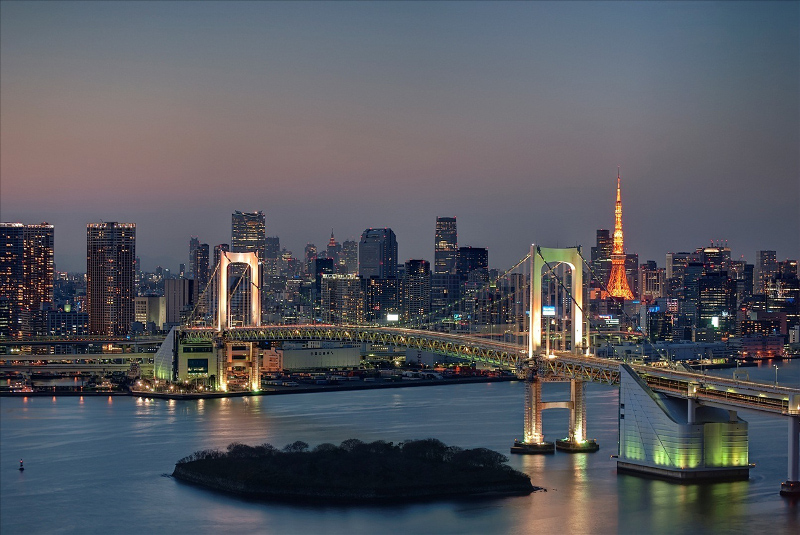
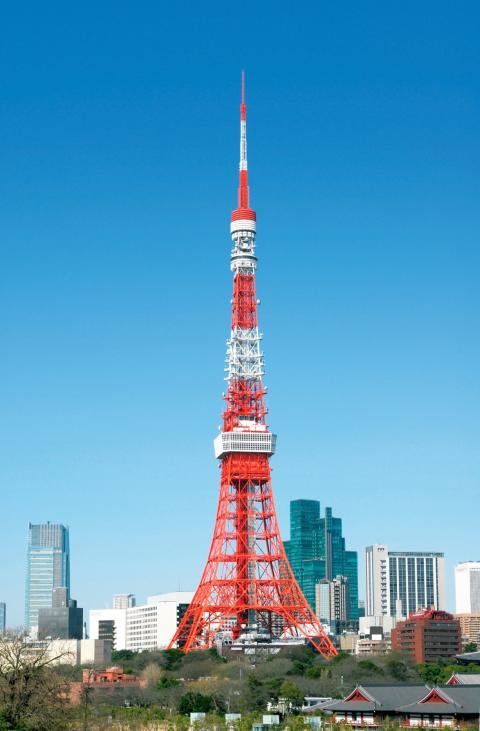
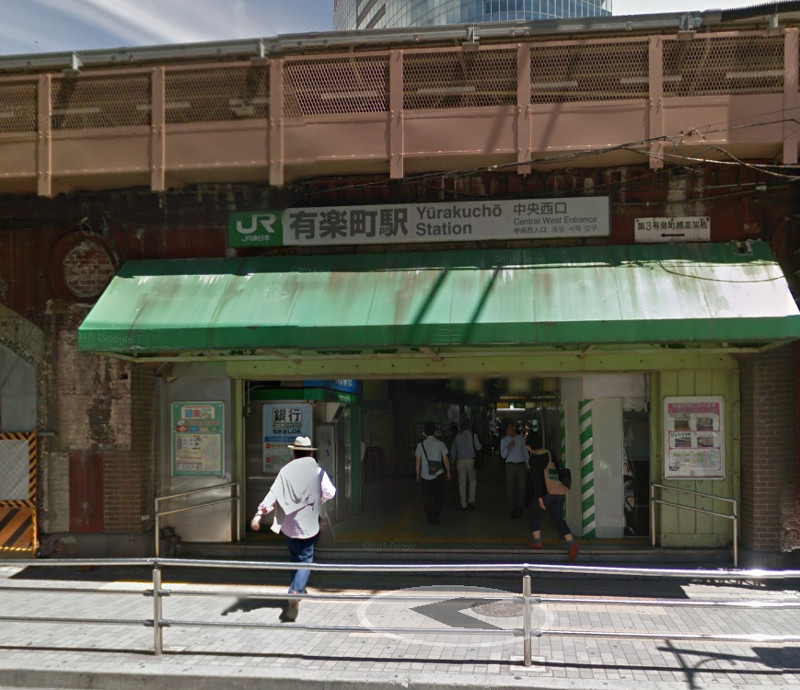
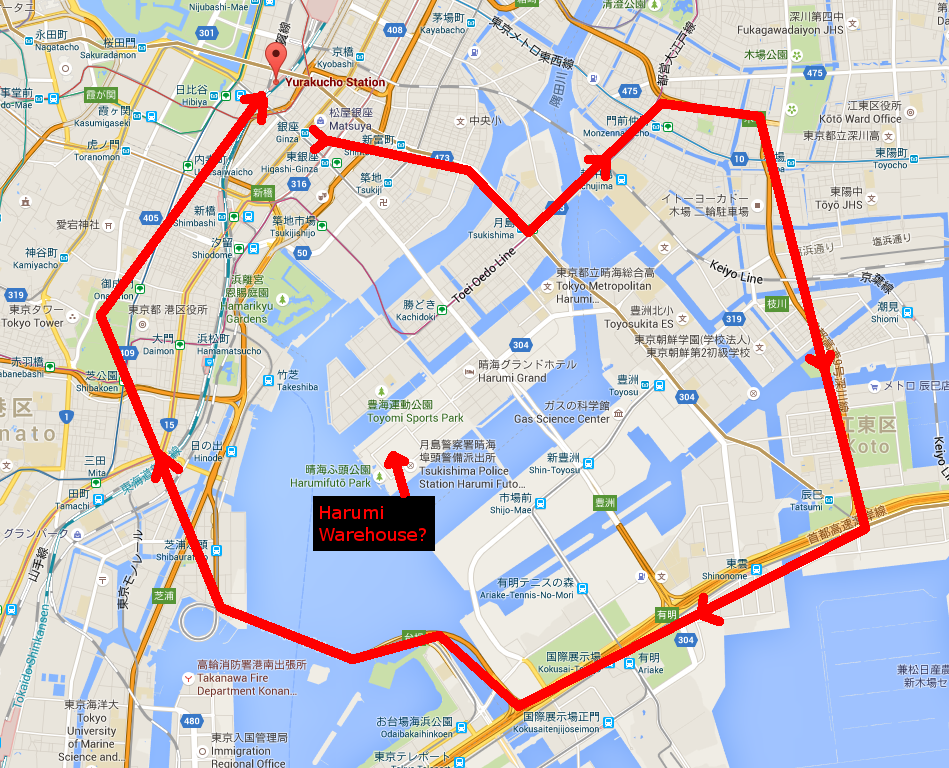
From the Warehouse, we took the Great Underpass towards Ikebukuro, where our hero awaits his trial and judgement at the hands of the Mantra demons.
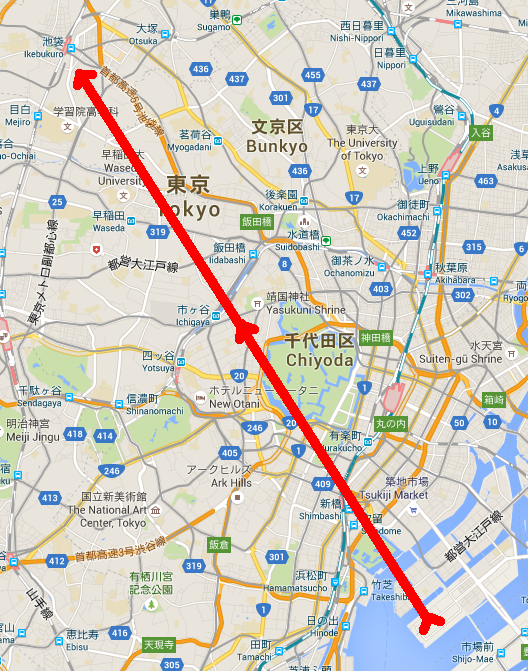
So, to summarize...
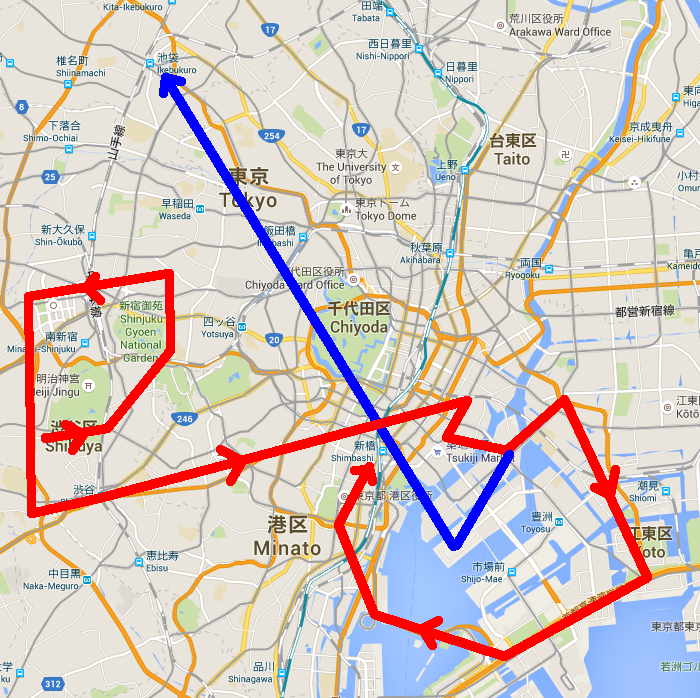
Good Lord I hope that made a lick of sense. Eyeballing it quickly, the places we've visited so far seem entirely comprised within a roughly 12km x 12km square. Here's a link to the general area on Google Maps, if you feel like looking around for yourselves; Street View's available pretty much everywhere!
4. Miscellaneous observations
***: Remember the lighting in the scene with Chiaki?
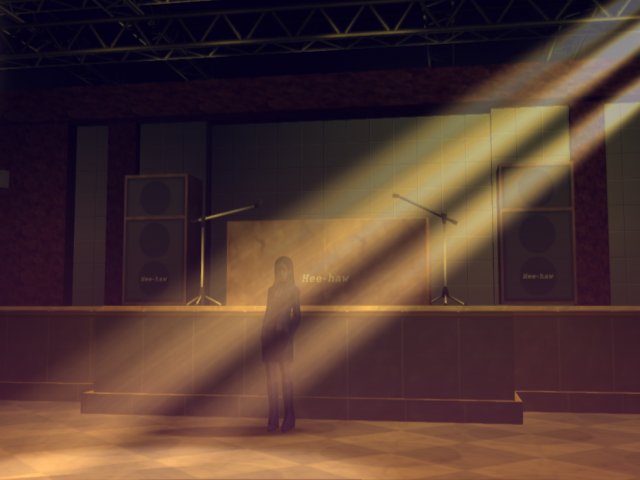
It's so warm and inviting, perfect for a reunion with a dear friend; a beautiful late afternoon sun... shining through a... through a window... Um.
There are no windows in the Shibuya underground, the sun never sets, and it always shines a sterile, bluish-white light. Our encounter with Chiaki had to happen in a club, because where else would you find yellow spotlights?
***: When I first played the game, I wasn't sure if there was meant to be a difference between magnetite and magatsuhi. Well, it turns out there is! They're in fact pretty much completely different.
In SMT 1 and 2, magnetite was a resource that you spent every step in order to keep your summons, well, summoned. If you ran out of magnetite, your current allies would gradually lose HP and die, and the stronger they were, the more magnetite they needed to consume. You could obtain more magnetite the same way you could obtain money: by killing demons, by finding it in chests, or by extorting it during conversation. In story terms, magnetite is a sort of universal demon nutrient that allows supernatural creatures to exist in the human world. It looks like green goop, and it's extracted from any being that has a physical body, including humans. When demons eat humans, it's not so much because they need protein and glucose and minerals and other mundane nutrients as much as it is because they need magnetite.
That said, there's no such thing as magnetite in Nocturne.
 : Which is a load of crap, by the way.
: Which is a load of crap, by the way. : What do you care? You never ran out! You had so much freaking magnetite you didn't know what to do with it!
: What do you care? You never ran out! You had so much freaking magnetite you didn't know what to do with it! : Look, I know magnetite shortage is a touchy subject for you, but we're on the same side, here. Namely, the side that thinks today's kids have it a little too easy.
: Look, I know magnetite shortage is a touchy subject for you, but we're on the same side, here. Namely, the side that thinks today's kids have it a little too easy. : Yeah, yeah, whatever, you're still a filthy bourgeois douchefuck.
: Yeah, yeah, whatever, you're still a filthy bourgeois douchefuck. : Why does everyone call me that?
: Why does everyone call me that? : So, anyway, what's the skinny here?
: So, anyway, what's the skinny here?*: Kagutsuchi's light is all the nourishment demons need in the Vortex World.
 : That's it? That's really it? Everyone's solar-powered?
: That's it? That's really it? Everyone's solar-powered?*: Yeah, pretty much.
 : Bah. Fie! Bah!
: Bah. Fie! Bah! : What about magatsuhi, then?
: What about magatsuhi, then?Magatsuhi is spiritual energy, generated, as we learned, by strong emotions. It can be seen floating through the air as little globs or pellets, and it can gather into pools as a concentrated red liquid, but unlike magnetite it's not a strictly physical substance, and though it grants power, it's not an essential nutrient that demons would need to consume in order to continue existing. The name "magatsuhi" itself means "spirit of calamity"; it's an integral aspect of the workings of the Vortex World, and in time we'll find out the exact reason it's so sought-after.
***: It suddenly occurs to me that you probably have no idea why I named our protagonist Francois "ZedPower" Hawke. Long story short, I named the SMT1 protagonist Francois because my name is François and there was no cedilla available, I named the SMT2 protagonist "Hawke" because he uses the pseudonym "Hawk" for a portion of the game and the idea that it was one letter off from his real name made me giggle. And I've been using the name ZedPower online for over two decades, though I've begun to shift away from it in the last several years. All put together, I felt it was a pleasant enough callback. And now you know!
***: The number 3 has some importance to the game's plot, as we'll learn before too long. This is represented in a subtle way in the designs for the Cathedral of Shadows and the Terminals.
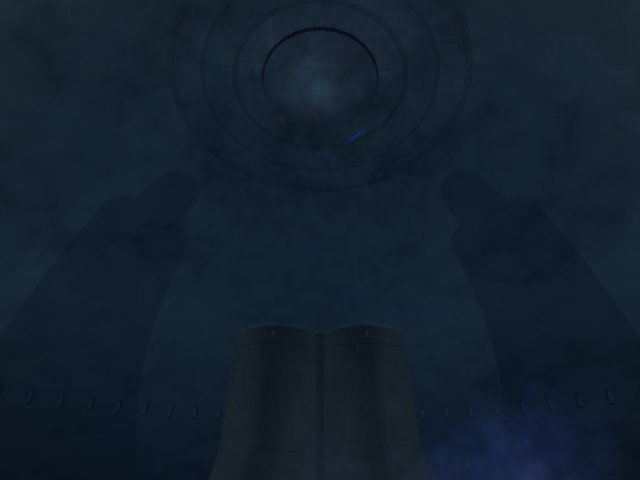
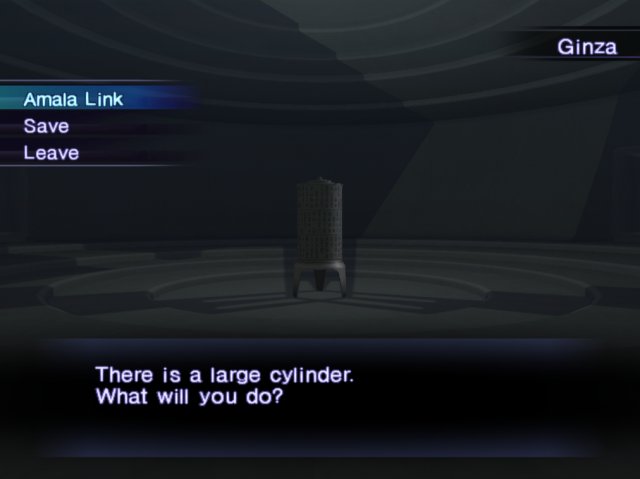
If you look closely, you can see that the structures in question cast three shadows (though the Cathedral's third shadow would fall on the camera).
***: The fact that Lucifer's "office" is clearly a theater set has some delightful symbolism to it.
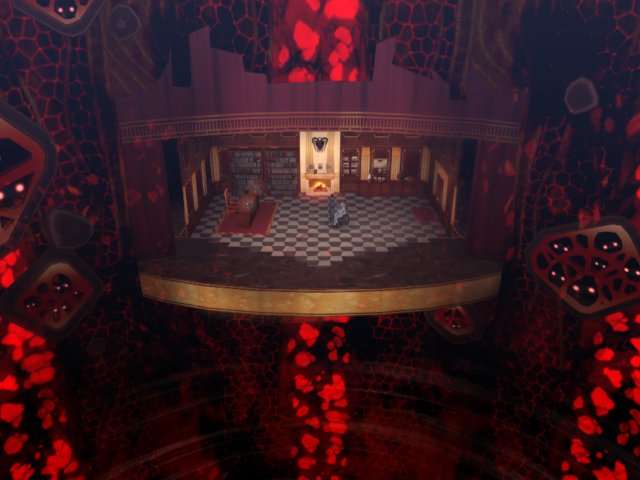
He's the Prince of Lies. He's hiding something. We know he's hiding something. He knows we know he's hiding something. He's not going to tell us the whole truth, but he's not going to insult our intelligence by pretending he's telling us the whole truth either.
If there's anything genuine in that spectacle, I think it's when Lucifer and the Lady in Black smile their confident, serene, and hopeful smiles.
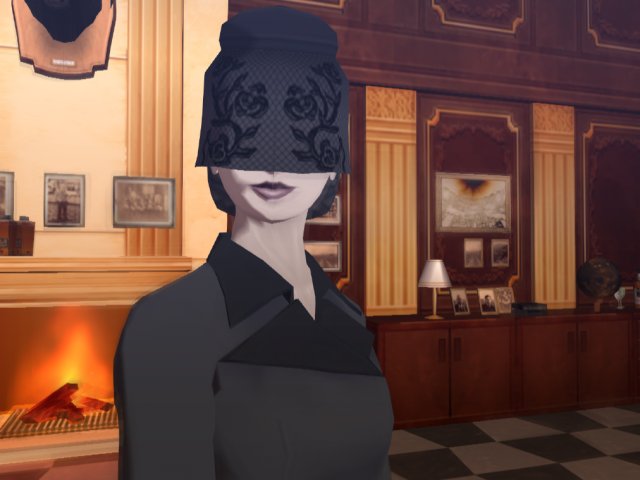
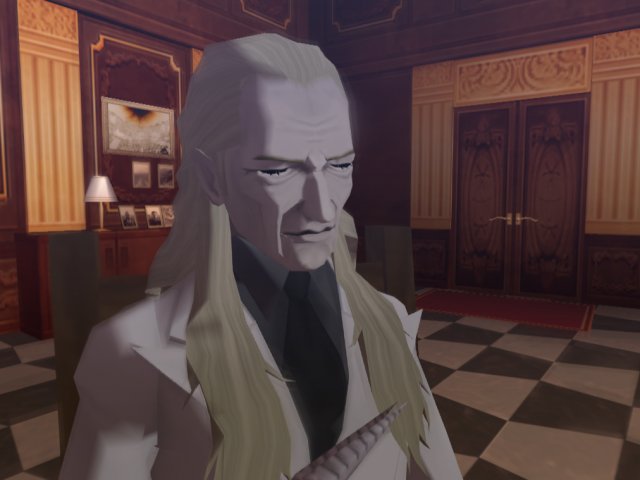
The plan is in motion. The time is near.
5. High-resolution pictures
I've taken a bunch of high-resolution screenshots at various points of the game so far. Rather than link them individually, I've uploaded them as an album on imgur for easier navigation. If you have any appreciation for the art style, I highly recommend checking it out! Fair warning: these are the original 1440x1080 PNGs for maximum quality, and they're practically a whole meg each.
6. Magic terminology
The spell names are a bit of a quirk in these series. Or to put it bluntly, at first glance they seem like random syllables glued together. If you're already familiar with spells, or just don't care that much, you can safely skip this section. Otherwise, you may be glad to learn that there's a method to the madness. Most of the time, there is.
At the core of each spell name is the name of the element of the spell, describing its basic effect. Nocturne has four main damage elements:
-Agi (fire)
-Bufu (ice)
-Zan (wind or force)
-Zio (lightning)
Additionally, there is the healing effect, named Dia, and you have the exorcism/expel spells and death spells, repectively Hama and Mudo.
When these basic names come with a suffix, they are a stronger version of the spell. This gives us Agilao, Bufula, Zanma, Zionga, Hamaon, and Mudoon. (Dia is a special case and comes with Diarama and Diarahan, which can be interpreted as midheal and fullheal.
New to Nocturne is another suffix, which is -dyne. It's only used for elemental damage spells, and indicates the very strongest version of that spell. So we have Agidyne, Bufudyne, Zandyne, and Ziodyne.
When the basic names come with a prefix (Ma- or Me-), they are a group-targeting version of the spell. We get Mahama, Mamudo, Maragi, Mabufu, Media, and so on. Spells with these prefixes always attempt to hit every opponent (or ally) once, unlike other abilities that randomly distribute a number of hits among the enemy party (like Tornado or Ice Breath).
A spell with both a suffix and prefix is a stronger, multi-hitting version of the spell. Therefore: Mazanma, Mamudoon, Mediarahan, Mabufudyne, and so on.
There is also another fairly uncommon element: almighty. It's essentially non-elemental. With very few exceptions, nothing resists, absorbs, nullifies, reflects, or is weak to almighty damage. I'm pretty sure it won't even exploit a weakness to magic, but don't quote me on that. All spells inflicting almighty damage hit the entire enemy party once; in order of strength, they're called Megido, Megidola, and Megidolaon. There are a few non-spell skills available that inflict almighty damage as well, but we'll note them as they become relevant.
The buffs and debuffs are little simpler. First you have four attributes:
-Taru (physical attack)
-Raku (phys/magic defense)
-Suku (accuracy/evasion)
-Maka (magic attack)
And then you have a suffix, -nda for debuffs, and -kaja for the buffs. Therefore: Tarunda, Rakukaja, and so on. Interestingly, there are only three debuffs: Tarunda debuffs both physical and magical attack power.
In addition, there are two spells to remove buffs and debuffs. Dekaja removes all -kaja effects from the enemy party, and Dekunda removes all -nda effects from the allied party. This functions even if the buffs and debuffs were not originally caused by -kaja or -nda spells, in the case of Fog Breath, War Cry, Taunt and the like.
One stack of any buff increases the relevant stat by 25%, and one stack of any debuff reduces the relevant stat by 12.5%. All of them stack up to four times, to a maximum of a 100% increase, or 50% decrease.
Well, that should be about all the spells with simple rules. The rest are mostly miscellaneous utility magic and I can stand describing those as we go.
---
*: Aaaaaand that's everything for now.
 : About time!
: About time!